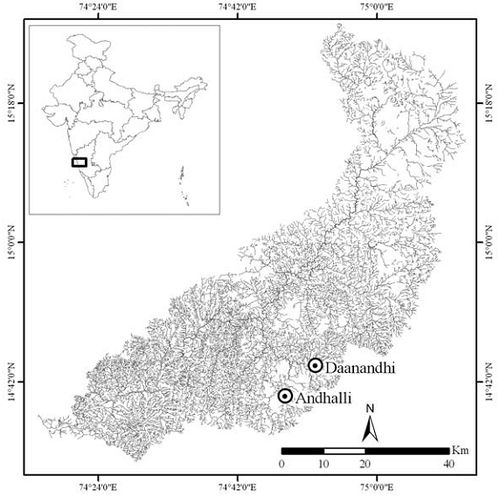|
B. Karthick 1, J.P. Kociolek 2*, M.K. Mahesh 3 and T. V. Ramachandra 1
1 Energy & Wetlands Research Group, Centre for Ecological Sciences, Indian Institute of Science, Bangalore – 560 012, India 2 Museum of Natural History and Department of Ecology and Evolutionary Biology, University of Colorado, Boulder, CO, USA 3 Department of Botany, Yuvaraja’s College, University of Mysore, Mysore - 570 005, India *Corresponding author, email: patrick.kociolek@colorado.edu MATERIALS AND METHODSTen first to fourth order streams were surveyed for diatoms and water quality assessment in the Bedthi River Basin, Central Western Ghats, Karnataka (Fig. 1) from January to December, 2006. Diatom samples were collected by vigorously scrubbing 3–5 stones from the substratum with a toothbrush and the resultant suspension was preserved in ethanol. A portion of sample was oxidized by the hot HCl and KMnO4 method (Taylor et al. 2007). Cleaned material was mounted onto glass slides with Naphrax mounting medium and observed with Olympus BX-51 light microscopes equipped with DIC and 1.4NA objectives. Digital images were taken with an Olympus DP-71 digital camera. Scanning electron microscopy was done with cleaned specimens air dried onto cover glasses, attached to aluminum stubs, sputter-coated with 10 nm of Au-Pd, and examined in high vacuum mode with a JSM-6480LV (LVSEM) at 15 kV, with a spot size of 15, and a working distance of 8 mm. SEM work was performed at the University of Colorado’s Nanomaterials Characterization Facility. In India, SEM work was accomplished with cleaned material air-dried onto cover glasses and sputter coated with ca. 10 nm of Au-Pd. Coated material was viewed in a FEI Quanta 200 ESEM at Indian Institute of Science Nanoscience Initiative Facility. Terminology on the diatom valves follows Ross et al. (1979). For features found in the gomphonemoid diatoms, we follow the terminology and character descriptions of Kociolek & Stoermer (1993). Water chemistry analysis were carried out as per the Standard methods for water and waste water analysis by American Public Health Association (APHA, 2005).
Citation: Karthick, B., J.P. Kociolek, M.K. Mahesh & T.V. Ramachandra (2011): The diatom genus
Gomphonema Ehrenberg in India: Checklist and description of three new species. – Nova Hedwigia
93: 211–236.
| ||||||


